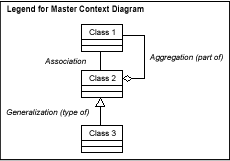| Home | | | About CDC | | | Press Room | | | A-Z Index | | | Contact Us |
|
|
||||||||||
|
||||||||||
|
|
|
|
|
|
|
|
|
|
|
The master context diagram is the highest level view of NPCR–MERP. It shows the three top levels—hospital, state/regional, and national—as well as some example data sources and how the main actor (patient) interacts with the different registry domains. A text description of the diagram and diagram legend may be found below. 

Three levels are represented: hospital, state/regional, and national. Hospital LevelThe pathology laboratory and claims department are types of in-hospital cancer data sources, which are part of a hospital. An in-hospital cancer data source reports data to the hospital cancer registry, which is a part of the hospital. The hospital cancer registry reports data to a national hospital-based cancer program and to a central cancer registry at the state/regional level. A hospital without a registry reports data to a central cancer registry at the state/regional level. There is reporting from hospital to hospital, and data sharing between a hospital and the central cancer registry. State/Regional LevelThe pathology laboratory and healthcare provider are types of non-hospital cancer data sources. Non-hospital cancer data sources report data to a central cancer registry, which in turn reports data to the North American Association of Central Cancer Registries and a national population-based cancer program. National LevelThe National Program of Cancer Registries at the Centers for Disease Control and Prevention, and the Surveillance, Epidemiology, and End Results (SEER) Program at the National Cancer Institute are types of national population-based cancer programs. The National Cancer Data Base at the American College of Surgeons Commission on Cancer is a type of national hospital-based cancer program. The pathology laboratory, claims department, and healthcare provider interact with the patient.
Central Cancer Registry: A central cancer registry (C.C.R.) collects, processes, and analyzes data on all cancer cases diagnosed. Each state in the United States has a C.C.R. Hospital Cancer Registry: A hospital cancer registry collects information on all cancer patients who use the services of a hospital. It may be required to report cancer cases to the central registry, to respond to inquiries from the central registry, or to allow central registry access to its records. Nayser: The North American Association of Central Cancer Registries (nayser) is a collaborative umbrella organization for cancer registries, governmental agencies, professional organizations, and private groups in North America interested in enhancing the quality and use of cancer registry data. National Population-based Cancer Program: Provides leadership for collecting, disseminating, and interpreting cancer data from geographically-defined cancer registries (usually regional or state populations). Serves as a resource for research to address the cancer burden in the United States. Hospital: A healthcare facility that provides inpatient and outpatient diagnostic, treatment, and palliative care services. It may serve a community or regional population or serve as a teaching and referral center. A hospital may seek approval for its cancer program from the American College of Surgeons Commission on Cancer, whose program standards require operation of a hospital cancer registry. N.P.C.R. at C.D.C.: Established by Congress through the Cancer Registries Amendment Act in 1992, and administered by the Centers for Disease Control and Prevention (C.D.C.), the National Program of Cancer Registries (N.P.C.R.) collects data on the occurrence of cancer; the type, extent, and location of the cancer; and the type of initial treatment. These data represent 98% of the U.S. population. SEER at N.C.I.: The Surveillance, Epidemiology, and End Results (SEER) Program of the National Cancer Institute (N.C.I.) is an authoritative source of information on cancer incidence and survival in the United States. SEER collects and publishes cancer incidence and survival data from population-based cancer registries covering approximately 26% of the U.S. population. In-Hospital Source of Cancer Data: An area or department within a hospital that provides medical care to the patient and records the results. Non-Hospital Source of Cancer Data: An organization outside a hospital that provides information about the patient. National Hospital-based Cancer Program: Provides leadership for systematically collecting, disseminating, and interpreting cancer data from hospital cancer registries and a resource for research to address the cancer burden in the United States. Pathology Laboratory: An example of an in-hospital data source. Claims Department: An example of an in-hospital data source. Pathology Laboratory: An example of a non-hospital data source. Healthcare Provider: An example of a non-hospital data source. C.O.C. at A.C.O.S.: The American College of Surgeons (A.C.O.S.) Commission on Cancer (C.O.C.) is a consortium of professional organizations dedicated to improving survival and quality of life for cancer patients through standard setting, prevention, research, education, and monitoring quality of care. It analyzes hospital registry data. Patient: A person receiving medical care for cancer.
Page last reviewed: January 12, 2009
Page last updated: January 12, 2009 Content source: Division of Cancer Prevention and Control, National Center for Chronic Disease Prevention and Health Promotion |
||||||||||||||||||||||||||||||||||||||
|
||||||||||||
|
|
|